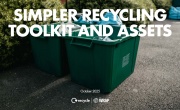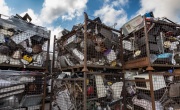Eye on the markets: Recycled paper goes through the mill
Simon Walker, Head of RCP UK at paper company UPM provides an update on the recycled paper market and what impact China's National Sword campaign is likely to have

The past 12 months in the UK have been chequered with turbulence and, above all, uncertainty, and that is no different for the recovered paper markets. Across the markets it has largely been static – some areas seem quite buoyant, while others less so, but overall there is a lack of clarity because of Brexit. The decline in exchange rate of the pound sterling following what was an unexpected referendum result has made exports of recovered paper more attractive. Domestic production of paper conversely is now more economically viable, and more attractive for precisely the reasons that put pressure on RCP (recovered paper) supply.
Different sectors have been performing better or worse, depending on prevailing trends. The newsprint sector is still under pressure from a declining market readership, with recovered paper prices hovering around £80-95 per tonne since January, while there’s currently an apparent structural change between mixed papers and cardboard at circa £70 and £130 respectively. Structurally, market for packaging is quite good and demand has been strong. Generally, as the price of RCP goes up, they are able to increase their sales price, which is not available to the newsprint sector. Mixed papers and OCC (old corrugated containers) fell quite significantly in the early months of this year, down to £60 and £85 per tonne from £100 and £123 per tonne between March and April.
Recent data provided by WRAP indicates that total paper packaging recycling totaled 955 thousand tonnes (kt) in the first quarter of 2017, down by 52kt in the same quarter in 2016, while recovered paper exports reached 272kt in December 2016, static from the previous December. UK reprocessing rose to 304kt and UK mill usage of recovered paper fell by 40kt compared to the previous year to 234kt in December 2016.

Something that has the potential to be disruptive is China’s new National Sword policy, an extension on its previous iteration as the Green Fence initiative. There is mooted political pressure for the Chinese to stop all imports of mixed level. It will be quite interesting to see what comes from that, because if that were to be the case then the European paper market would be in turmoil. The current uncertainty is leading to a change in the OCC (Cardboard) grade with more mixed being included in the grade and it moving to an 80:20 ratio from a more usual 90:10 or higher.
 This article was taken from Issue 88
This article was taken from Issue 88The background to National Sword is more to do with stopping the smuggling of goods than anything to do with paper, but searching for contraband has led to discoveries of contamination in mixed paper deliveries in particular. China does not want to be the dumping ground for poor quality. China insisting on higher quality is quite welcome, but it means exporters and export-based countries may have higher volumes of paper that are more difficult to move.
Accordingly, contamination prevention strategies will have to be rethought. People have more stringent targets now and what that means is they are either having to slow down sorting procedures, or be much more robust with inbound materials from the local authorities. I think that more will come back towards local authorities in terms of sharing the costs of contamination. It’s likely that we’ll increasingly see more of a shared risk element through setting a more realistic gate fee for material to come in and then some prospective share of the value of the outputs. If there’s quality input, there’s quality output.
It’s difficult to gauge the future prospects for the industry at the moment. In the very short-term, we’re living in limbo over Brexit. I think there’s a growing call for some degree of pragmatism in terms of conditions for businesses to operate in. Energy costs are too high at the moment, higher than anywhere else in Europe, and for an energy-intensive industry that poses a problem. We need our government to look at how our indigenous production can be protected. Meanwhile, veering between the extremes of threatening to leave the EU with no deal if we don’t get our way, and going after a deal at any cost are not providing business with a stable platform to work with.
Maybe some ‘strong and stable’ leadership wouldn’t go amiss – to coin a current phrase!










